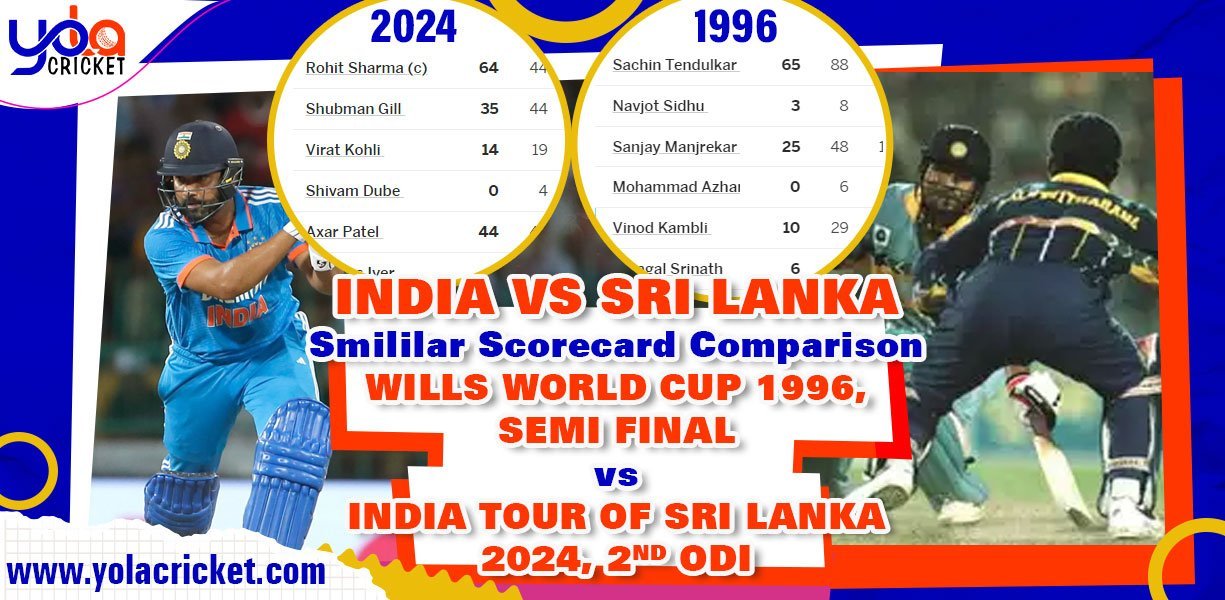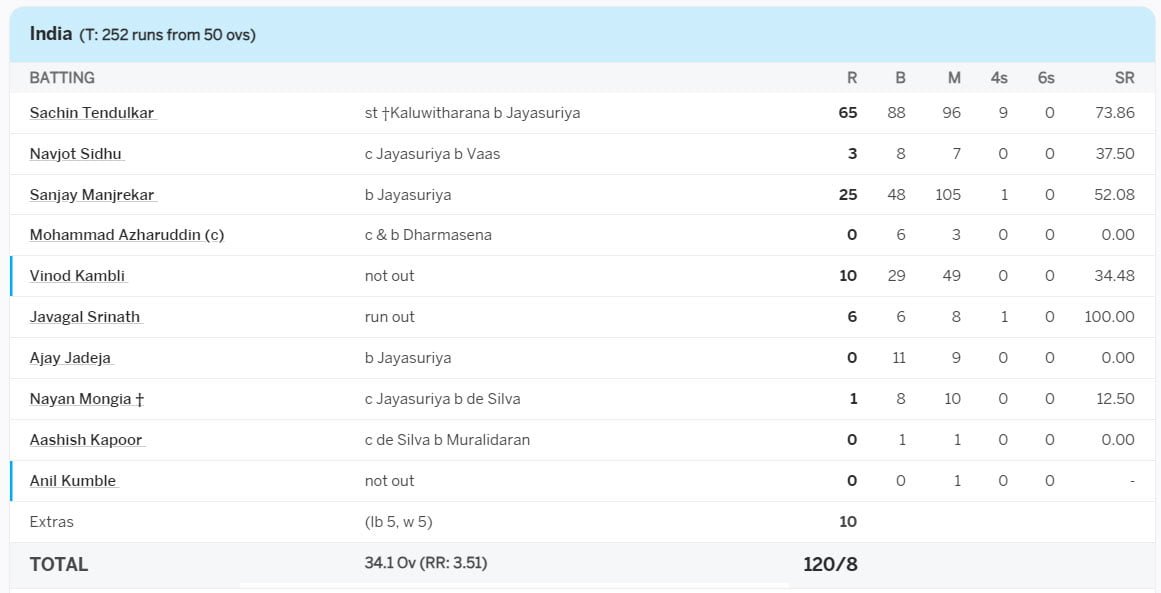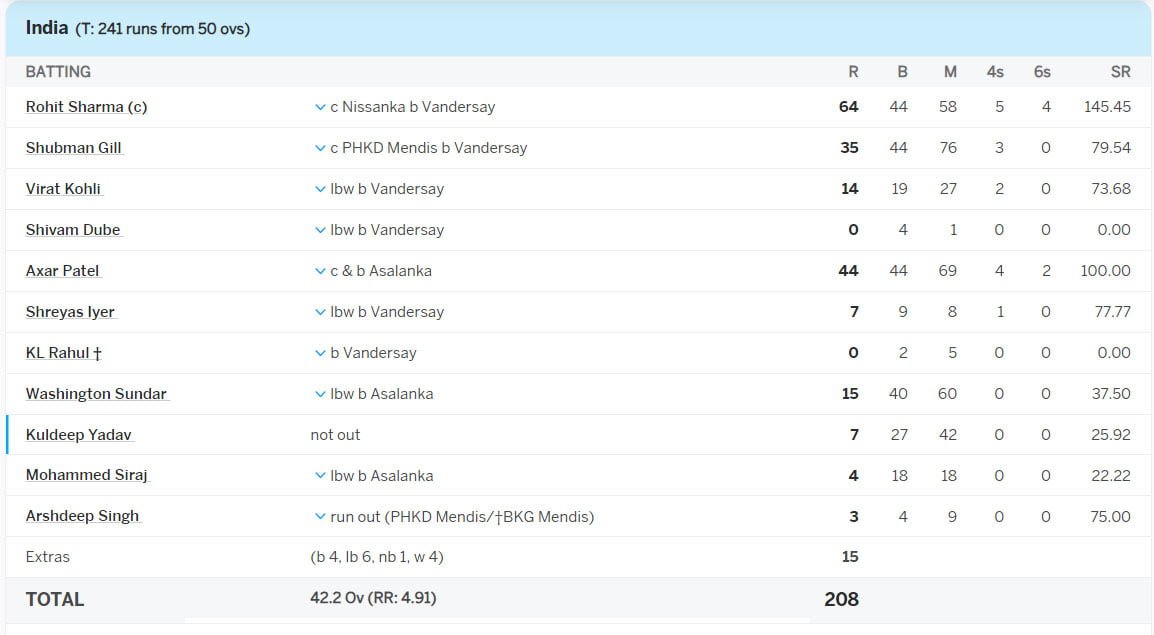
Comparison between the India vs Sri lanka Match 1996 Wills World Cup, Semi Final and Ind vs SL 2024 2nd ODI
One should analyze the two contrasting performances of India and Sri Lanka in the game of cricket, more so in case of important matches. You may take the instance of the most memorable semi-final game of the 1996 World Cup played at Eden Gardens to find how pressure affected players and strategies. This blog will walk you through those moments of that game, underscoring India’s cataclysmic collapse from strong starts and the Compact resolve of Sri Lanka in stitching together a win. Go through the analysis here and understand what worked in both rounds of these memorable encounters.
Important Takeaways:
- Historic Context: The 1996 WC semi-final at Eden Gardens is still remembered as one of the most big-ticket collapses of the Indian cricket team against Sri Lanka.
- Batting Collapse: In the ’96 game, India slid from a highly precautionary position of 98/2 to 120/8, evidencing a steep drop in performance that can only be ascribed to one of poor batting displays.
- Distinguishing Players Ind vs SL 2nd ODI 2024: Unlike the past, this time around, notable contributions of high magnitude were evident in the persons of Rohit Sharma and Axar Patel, whose runs mounted to 64 and 44, respectively.
- Top Scorers: In the last outing barring Rohit and Axar, Shubman Gill was the only other batsman who really came good, making 35 runs.
- Disappointing Support: The similarity with 1996 lies in the way, barring a couple of batsmen, none of the other batsmen could cross the 15-run mark.
- Chasing Challenges: Both the matches show the chasing challenges of India vs Sri Lanka, bringing to the fore the difficulties of playing under pressure.
- Lessons Learnt: The historical performance against Sri Lanka acts as a reminder to the present and future players to keep cool and deliver under pressure.
Historical Background
This rivalry between India and Sri Lanka is a part of cricket history, exhibiting some of the most memorable moments and nail-biting encounters for enthusiasts. Development of this rivalry over the years has taken the shape of hard-fought matches and gripping finishes, making this a plethora in the world of One Day Internationals. High stakes World Cup clashes to memorable bilateral series—you will find almost every match seems to be scripting a new chapter to this heated rivalry.
Overview of India vs Sri Lanka Rivalry
It is within this context that one would be able to understand the deep rivalry that is shared between these two teams. Not only have the teams played each other several times since their first ODI encounter in the year 1979, but with every match, stakes were raised and passion increased among the fans. Most notably, the semifinal of the 1996 World Cup remains fresh in the minds of many, as that was truly one of the most memorable moments taken from their competitive history.
Major ODI Milestones
It is part and parcel of ODI history that matches between India and Sri Lanka have their share of high and low points. You must remember the historic victories in 1983 and 2011 World Cups when India won, but very important to recall here the jolting memories as well of the 1996 semi-final collapse at Eden Gardens, where India slipped despite needing only 241 runs with good knocks from Rohit Sharma and Axar Patel.
Think of instances, like the semifinals of the 1996 World Cup, and this perhaps defines what competitive cricket has been: a trough immediately after reaching peaks, which only adds to the charm of the rivalry. The game stood out, revealing both the potential and vulnerability of Indian batters, which swings under pressure to a disappointing defeat by 32 runs against Sri Lanka. You can understand why this rivalry is so thrillingly alluring with moments like these, in stark contrast to each other, etched in history.
India vs Sri Lanka Overview of the match
Some of the fans might remember the infamous semi-final match between India vs Sri Lanka at the Eden Gardens in Kolkata, which dates way back in 1996. The Indian batsmen fell apart dramatically from a very promising start to finally end up at 120 for 8 while chasing a modest target of 241 runs. This game will be marked in record books, not for what happened, but the sense of tension that prevails in the stadium with the dwindling hope in the eyes of the home crowd is palpable. The rising trajectory of this match can be better understood in the Sri Lanka vs India, 1st ODI Over By Over Comparison, Live .
Match Format and Rules
The format for the contest between India versus Sri Lanka was an ODI contest with 50 overs for each side. The match allows each team to score runs during a time period and helps one to score as many runs as possible over that of the opponent. It is played with a white ball, combined with great pressure, making the game all the more important to that player and his country.
Significance of the Match
That match difference does not function only as statistics, more so in the context of this 1996 World Cup semi-final. You had two powerhouses of cricket who could swing the complexion with every play. It was an important moment for India, fighting not only against Sri Lanka but also the whole crowd cheering and supporting the opponent team in their homeland. This defeat shows how fast things can change during a game of cricket.
Match performances often resonate in your memory, shaping future strategies and playing styles. That game has been a historical lesson of how much the winning process holds under pressure. As much as India lost that day, the experience of resilience and requisite team performance comes out very importantly and affects successive generations and their approach to the game.
Player Performances
Although a lot of hopes had been set out for the Indian team, during the semi-final game against Sri Lanka, the players performed below par. It was a game of contrasting performances by both teams, shedding deep insight into what made or broke the teams on that fateful day.
Key Indian Players on 1996, Wills World Cup, Semi Final match

Image Source – Cricinfo.com India vs Sri Lanka, 1st Semi-Final at Kolkata, , Mar 13 1996 – Full Scorecard
The fall of Sachin Tendulkar saw the Indian batsmen collapse like a house of cards. From the good 98/2, the Indian team was tumbled to 120 for 8 with a dramatic collapse. Vinod Kambli came to bat at No. 5 but saw his teammates come and go within seconds.
The most annoying dismissal was that of captain Azharuddin, who was given out by Kumar Dharmasena at 0. Kumble went defensive with 10 runs from 29 balls as India was reduced to 120/8 in 15.5 overs. This remained one moment that really weakened India’s innings and strengthened Sri Lanka’s resolve.
On this day India and Srilanka faced each other during 1996 World cup semi final. If we can summarise in one pic 😐 pic.twitter.com/Gl76p1MaVI
— Sachinist (@Sachinist) March 13, 2021
Key Indian Players on India vs Sri Lanka 2nd ODI, 2024

Image Source – Cricinfo, Sri Lanka vs India, 2nd ODI at Colombo, SL vs IND, Aug 04 2024
The performances from the Indian side were primarily anchored by skipper Rohit Sharma, who scored a brisk 64 off 44 balls, and Axar Patel, who put in a determined effort of 44 off 44 deliveries. But rest of the batting folded like a pack of cards as India suffered a dramatic collapse, losing their way from 97/1 to 208/10.
Not to forget, the scintillating performance by Vandersay, who finally ended his spell with 33 runs for 6 wickets, was more or less decisive in this match and almost forced India to surrender.
While Patel’s efforts were invaluable, they fell just a little short of helping India win the match. Sri Lanka were good at converting Indian weaknesses to their advantage due to their strategic bowling and resilience. Their team effort in keeping the Indian batters at a measly 120 runs was instrumental in securing a memorable 32-run win, no doubt a high point in the history of Sri Lankan cricket.
Statistical Analysis
Though of course the game was an aggressive one, unlike other face-offs between these two nations where the battle was head-on, this recent face-off pushed out the window a dramatic performance and statistics depicting the strengths and weaknesses of each team. You can further delve into the statistics of the match when you click on SL vs IND match statistics: Sri Lanka vs India 2nd ODI Stats, to give you more in-depth coverage of this game.
Averages and Contributions of Batsmen
The way India’s batting line-up has been, it showed a huge contrast with their averages going into a big game. Rohit Sharma and Axar Patel were the only significant contributors, scoring 64 and 44 runs respectively. All other batsmen made minimal contributions, not a single batsman going over the mark of 15 runs, similar to the 1996 semi-final scene when the collapse was just the same.
Bowling Performance Metrics
The bowling performance also goes on to explain the outcome of the match. The Sri Lankan bowlers, especially Kumar Dharmasena, leveraged the fragile Indian performance in batting to their advantage. The pressure exerted through efficient bowling finally did it for India despite Rohit’s valiant effort.
Averages further underline the performance gap; Sri Lankan bowlers have kept the economy rates low and taken vital wickets at important moments. Their disciplined bowling plan really worked in demolition man-like fashion over India’s batting, much like some of the previous encounters where strategic bowling really came good for gains. Appreciating these metrics allows you an insight into the strategic nuances that influenced the outcome of the game.
Impact of Crowd and Location
Keep in mind that the atmosphere in a cricket game could have huge effects on how well players perform. But more than that, the crowd in Kolkata, particularly at Eden Gardens, is emotional and vocal for their home team. When the crowd is with them, it very often lifts spirits and enhances performance. More of this dynamic can be read in the article on IND vs SL 2024 2nd ODI Match Today: Playing XI .
Importance of Eden Gardens
There can hardly ever be an exaggeration of the importance of Eden Gardens, one of the most iconic cricket fields in the world. With an audience of more than 66,000, it brings out a very energetic atmosphere that may either act to batter or motivate players. The historic relevance of the ground and the fieriness of a Kolkata crowd would often turn any match into a spectacle remembered for ages.
#OnThisDay in 1996, Sri Lanka beat India by default in the World Cup semi-final in Calcutta.
Chasing 252, India went from 98-1 to 120-8 when the crowd set fire to some areas of the stands and threw water bottles at fielders.
A forgettable day for Indian cricket. pic.twitter.com/uBtNklOZcn
— Wisden India (@WisdenIndia) March 13, 2021
Home Advantage:
It can even be mentally and physically derived from playing in familiar surroundings. Players know the pitch conditions and thus can adapt strategies to make them perform better. It is, for instance, the 1996 semi-final, wherein the pressure of playing at home might have added more salt to the wounds of the Indian team after their defeat against Sri Lanka.
Research clearly shows that home teams have an advantage in the majority of games of sport; cricket is no exception. This is more relevant in high-stakes matches such as a World Cup semifinal, where the expectations from the local fan base may sometimes amplify the pressure. As India tumbled from the promising 98/2 to 120/8 during that 1996 match, so too did the Eden Gardens crowd, reflecting the emotional see-saw of that match. Knowing these factors, you can have a better view of how much support and a familiar venue can be crucial for a team.
Post-Match Reactions
Now, as the dust began to settle over the Eden Gardens in Kolkata, the reactions around India’s lackluster performance were sharp and diverse. The game played on 13 March 1996 has found a place in cricket lore, followed by an entire gamut of emotions from players, fans, and analysts alike.
Media Coverage
The media was rife immediately after the match, carrying reports of India’s batting collapse against Sri Lanka. Outlets emphasized the jaw-dropping fall from 98 for 2 to 120 for 8 and pointed out that the players were unable to handle pressure, as all but Rohit Sharma and Axar Patel stumbled. It questioned their preparedness and strategic approach.
Many in the stands were conspicuous by their disappointment as they watched India lose by 32 runs while chasing what was, by all means, a gettable target of 241 runs. What began on a note of hype at the Eden Gardens gradually turned into a solemn one, portraying disbelief and frustration among supporters.
Rohit Sharma said, "the reason I got 65 is because of the way I batted. I don't want to compromise on my intent". pic.twitter.com/PEdxWwfYze
— Mufaddal Vohra (@mufaddal_vohra) August 4, 2024
One can feel the emotional landscape of the fans—here, the great bonding they have with the team. Your expectations were sky-high when Rohit Sharma played that valiant 64 from 44 balls. The overall lack of contributions beyond Shubman Gill’s 35 and Axar fighting 44 overshadowed the hopeful moments. This game has not only been a painful reminder of what could have been; it has also raised several passionate discussions regarding team strategy and future performance.
Summary
The contrasting performances of the India vs. Sri Lanka matches underline individual performance as the raison d’être. If in the 1996 semifinal, only Tendulkar and Kambli showed some sort of endurance while their team collapsed in dismal fashion, this time around it saw Rohit Sharma and Axar Patel stitching on a solid performance. What comes out, however, is a common strand between the two: disappointment whenever collective batting fails to rise to expectations—underscoring further that for your favourite players to succeed under pressure has to be continuous.

Categories
Trending News
-


Cricket Viral News 2024
/ 1 year agoBCCI announces India’s 1st Test squad against Bangladesh; Kohli, Pant back, Iyer dropped
Latest indian cricket news: As reported, BCCI Announces India’s First Test Squad vs Bangladesh...
By Yolacricket -


Cricket Viral News 2024
/ 1 year agoCricket news update today: International cricketer Moeen Ali retires
England all-rounder Moeen Ali, retires from all forms of international Cricket news update today...
By Yolacricket -


Cricket Viral News 2024
/ 1 year agoBreaking cricket news: Ollie Pope Breaks 147-Year Record
Breaking cricket news: Ollie Pope Achieves Near-Impossible Feat First in 147 Years of Test...
By Yolacricket -


Cricket Viral News 2024
/ 1 year agoWho is Musheer Khan? scored 105* runs during the key India B innings in the Duleep Trophy 2024
Who is Musheer Khan? Learn about Indian cricket’s most promising all-rounder. Musheer Khan is...
By Yolacricket -


Cricket Viral News 2024
/ 1 year agoSuryakumar Yadav’s hand injury will keep him out of Duleep Trophy 2024 first round
Suryakumar Yadav’s hand injury will keep him out of Duleep Trophy 2024 first round...
By Yolacricket -


Cricket Viral News 2024
/ 1 year agoENG vs SL: Joe Root’s 34th Test century breaks Alastair Cook’s England record
Joe Root’s 34th Test century overtakes Alastair Cook’s England record, equals Lara, Gavaskar with...
By Yolacricket -


Cricket Viral News 2024
/ 1 year agoDuleep Trophy 2024 updated squad: Jadeja released, Siraj & Malik ruled out
Changes in Duleep Trophy 2024 Team You all must have turned a glance at...
By Yolacricket -


Cricket Viral News 2024
/ 1 year agoPakistan vs Bangladesh live: BAN Defeats PAK in First-Ever Test Match
Pakistan vs Bangladesh live: Bangladesh Creates History with Thrilling Test Win Over Pakistan. Cricket...
By Yolacricket -


Cricket Viral News 2024
/ 1 year agoShikhar Dhawan retired from both international and domestic cricket
Shikhar Dhawan retired moment remembers Indian cricket’s glory days: “In my first five years...
By Yolacricket -


Cricket Viral News 2024
/ 1 year agoKL Rahul Retirement News: “I Have Announcement To Make” – Insta post goes viral
KL Rahul Retirement News: Is KL Rahul’s rumored retirement a swing and a miss...
By Yolacricket























